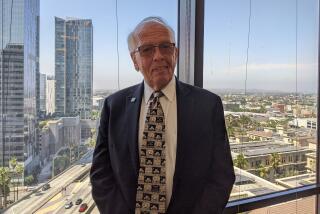Doctors Go Out of Way to Provide Care : Medicine: New Mexico program brings physicians to rural communities starved for medical attention.
- Share via
ALBUQUERQUE, N.M. — Dr. Kevin Edwards’ first patient of the day at a clinic for the homeless is a middle-age woman named Margaret, who was shot in the hip a couple of weeks earlier. Edwards is one of New Mexico’s physicians on wheels.
“How’ve you been doing since then?” Edwards asked.
“Lousy,” replied the woman, who moaned quietly as she rested on an examination table at Albuquerque Health Care for the Homeless. “My leg hurts all the way down. It hurts so bad I can’t sleep.”
Edwards, who sees up to 35 patients a day, or sometimes as few as one, pokes and prods and listens to the woman’s words and heart and lungs. He gets a medical history, suggests physical therapy, prescribes treatment.
Edwards is one of 55 doctors who participate in a program called Locum Tenens, Latin for “to take the place of.”
Although not the clinic’s regular physician, he’s at ease working with people who don’t always know where they’re going to sleep at night.
In this case he arranged for money so the woman with the hurt hip could spend a few more days in a hotel before returning to the streets.
Normally he works for the University of New Mexico Health Sciences Center, but he is also part of this program designed to provide doctors to rural communities who are starved for medical attention.
The New Mexico Legislature has approved $200,000 annually for the program, which began in 1993. That’s about 30% of Locum Tenens’ budget.
Edwards divides his time between running the program for internal medicine and his faculty job. There also are pediatric and family practice branches in the program.
Dr. Dan Derksen, program coordinator, says the benefits of Locum Tenens reach beyond giving communities some respite while they seek steady medical care.
“One of the unanticipated benefits is to provide coverage while the community is doing a recruitment effort to bring a primary-care physician into the community,” said Derksen, also a faculty member at the University of New Mexico Health Sciences Center in the department of family and community medicine.
Edwards’ stints have ranged from a day at a Cuba, N.M., clinic to a couple of weeks at a group of clinics spread out over northern New Mexico.
“One of the biggest problems with doing rural health care is that health care workers really feel isolated,” Edwards said. “When you work by yourself all the time, you really miss that interaction.”
“I’ve worked in a lot of general practice primary care clinics where I see everyone who walks through the door,” Edwards said. He does physical exams, stitches cuts, treats acne.
A day at a clinic in a tiny village could end without a single patient, or with the whole town lining up at the door with the flu.
In the course of his rural practice, he encounters everything from diabetes to kidney disease to heart failure.
Dr. Mark Unverzagt knows what Edwards is talking about.
A family practitioner, Unverzagt is the lone physician at Catron County Health Center in Reserve, N.M., the only health care facility in an 8,000-square-mile area in southwestern New Mexico. The nearest hospital is 100 miles away in Silver City.
“We take care of anybody who walks through the door,” said Unverzagt, who works with two nurses. “The types of problems are unlimited.”
Locum Tenens “allows me to take full advantage of my leave time,” Unverzagt said. “We could get people from other places, but the nice thing about the university is that for the most part it’s a known quantity. You get somebody filling in who’s capable of doing a good job.”
Once, a female Locum Tenens physician working for Unverzagt provided him more than a chance to take time off.
While using a chain saw to trim trees and branches, he sliced his hand and required a dozen stitches.
“She helped sew it up,” Unverzagt said. “It was kind of good because the resident here was an internal [medicine] resident and hadn’t done much sewing, so I was able to show her how.”
The program sustains itself on a sliding scale, Derksen said, so doctors or clinics in medically underserved areas pay the lowest rates.
Derksen says the two weeks he spent covering for an Alamogordo physician gave him a better appreciation for the complexity and intensity of a rural practice.
“I found out from my experience what it’s like to call into the university to get a consultation, what it’s like to arrange a transfer” for a trauma patient, he said. “When you’re out there waiting, you really get a better appreciation for what you need to know and how much you depend on a responsive health care system in the state.
“So when I come back to the university, I’m a better consultant, a better access point to physicians out there, because I understand what they do. I can make our system more user-friendly for the physicians out there.”
More to Read
Sign up for Essential California
The most important California stories and recommendations in your inbox every morning.
You may occasionally receive promotional content from the Los Angeles Times.










